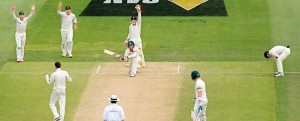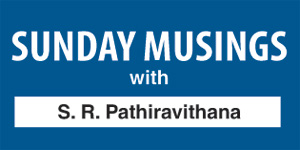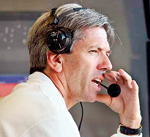Llong’s Lyon hearted hot spot
View(s):
Flashpoint: During the inaugural Day-Night Test match, Nathan Lyon plays the sweep shot that was to later create a furore over Llong’s third-umpire decision
Come Thursday, the first Test between Sri Lanka and New Zealand will be on show — a game seemingly tilted towards the superior skills of the Kiwis than the ‘greenhorn’ Lankans. So obviously for the Lankans it will be an uphill task, but it does not send shudders through me. Now as far as I am concerned the nerve chilling experience would be to stand in the middle with ICC Elite Umpire Nigel Llong during the Test series.My fears that a brash, irresponsible umpiring decision could bring a different result to a cricket match have come true. As a result of that horrendous decision by Nigel Llong in that first ever day-night Test match between New Zealand and Australia, we saw a completely different scenario being depicted as the final result. In a game where the New Zealanders could have squared the series at 1 all, the series stormed into a 2-0 series win for the Australians.
 New Zealand coach Mike Hesson was furious and upset at the end of the series. New Zealand authorities contacted the International Cricket Council seeking answers over a contentious review that went against them. Australian late order batsman Nathan Lyon survived a caught-behind appeal although the “Hot Spot” thermal imaging revealed a mark on the back of his bat before he had scored. It was a major let-off for Australia, in trouble at 118 for eight and still trailing the Kiwis first innings total by 84 runs in a low-scoring Test.
New Zealand coach Mike Hesson was furious and upset at the end of the series. New Zealand authorities contacted the International Cricket Council seeking answers over a contentious review that went against them. Australian late order batsman Nathan Lyon survived a caught-behind appeal although the “Hot Spot” thermal imaging revealed a mark on the back of his bat before he had scored. It was a major let-off for Australia, in trouble at 118 for eight and still trailing the Kiwis first innings total by 84 runs in a low-scoring Test.
ICC chief executive Dave Richardson told the Sydney Daily Telegraph he was almost certain that Llong followed the correct “process”, and in the end it boiled down to a “judgment call”.Later the ICC machine also admitted their faux pass — they noted. “The International Cricket Council has admitted third umpire Nigel Llong’s crucial decision in the day-night Test was wrong. Llong ruled there wasn’t conclusive evidence to dismiss Nathan Lyon during Australia’s first innings at Adelaide Oval. NZ coach Mike Hesson took the issue up with match referee Roshan Mahanama, then NZC wrote to the governing body.”

Nigel Llong
Yet at the end of the day the ICC may come up with petty excuses for its blunder, but, there are followers of the game who still keep asking the questions about the credibility of the Decision Reviews System and the integrity of some of the elite umpires.
Here we are putting forward some of the question that have been put forward by the followers of the game.
They ask — is the ICC serious about its modus operandi. Unlike in the past, Test cricket is a highly professional game, played by professionals for high stakes and the game is expected to progress above board at all times. But, there are times in spite of the technology that they have at their disposal, still there are almost stupid decisions going abegging at crucial matches, such as the Llong folly.
Now obviously Llong would be under a lot of duress during the New Zealand-Sri Lanka series. There may be antipathy against Llong by the New Zealand cricket loving public. The chances of the umpire trying to make amends during the series also loom.
Some even ask if the brash decision taken by Llong was as a result of Australia being a ‘Top Three’ member.
There are even contentions that the ICC has its own favourites in naming umpires for certain series. It is certain that that the Llong episode has taken a lot of sheen off the public image of the DRS and the ‘Elite; umpires. So to get an insight of a local umpire, the Sunday Times spoke to former ICC ‘Elite’ umpire Asoka de Silva about the incident. We asked him about the intensity of the incident and what views he had on the subject.
De Silva said, “First of all, the Decision Reviewing System was brought into eliminate umpiring blunders and make decisions more credible. So the top umpires in the world have the determination and inclination to uphold the highest standards in umpiring. To do that they are provided with so many guidelines like the hot spot, the thermo spot, sniko and the line call along with a battery of TV cameras. If I am the third umpire and the evidence is clear enough and the onfield umpire has said that a batsman is out, I have to go by the evidence and make the call accordingly if the matter is reffered to me. This is the fundamental law and no one can change that.
“However, when I am asked about the credibility of the umpires what I could say is that even during the last World Cup there were certain cloudy instances. But, in those instances the ICC took up those matters and gave the necessary feedback. As far I am concerned I will not encourage anyone to do the wrong thing while standing at a match at any level. By chance if that occurs I think that all the cricket enthusiasts will lose their faith in the system. The calls come as various circumstances under different conditions, but, all of them are professionals and it is their bread and butter, so I think no umpire will go to the level of taking a wrong decision willingly”.
However, in this instance, the matters may be different. In a post-match comment, even Australian coach Darren Lehmann said: “If it was me I would have let the batsman walk back to the pavilion”. Referring to the Llong decision, former Australian captain Ian Chappell also said: “It did unsettle the New Zealanders. Brendon McCullum is not a whiner, but I do not know how the hell the third umpire arrived with that umpiring decision.”


